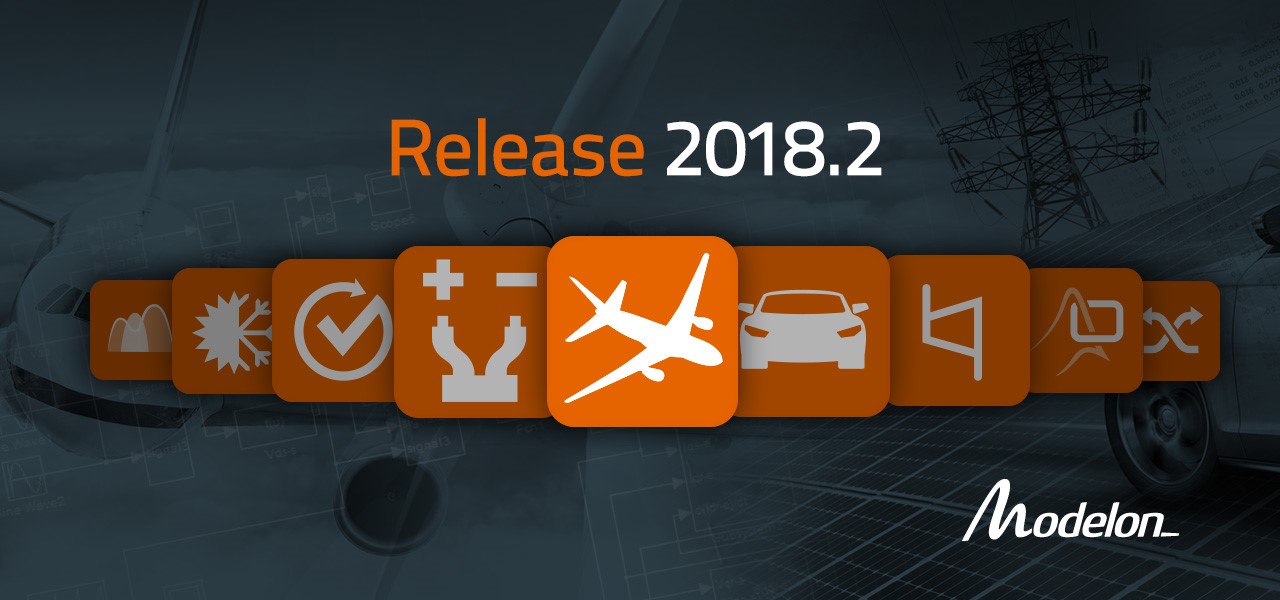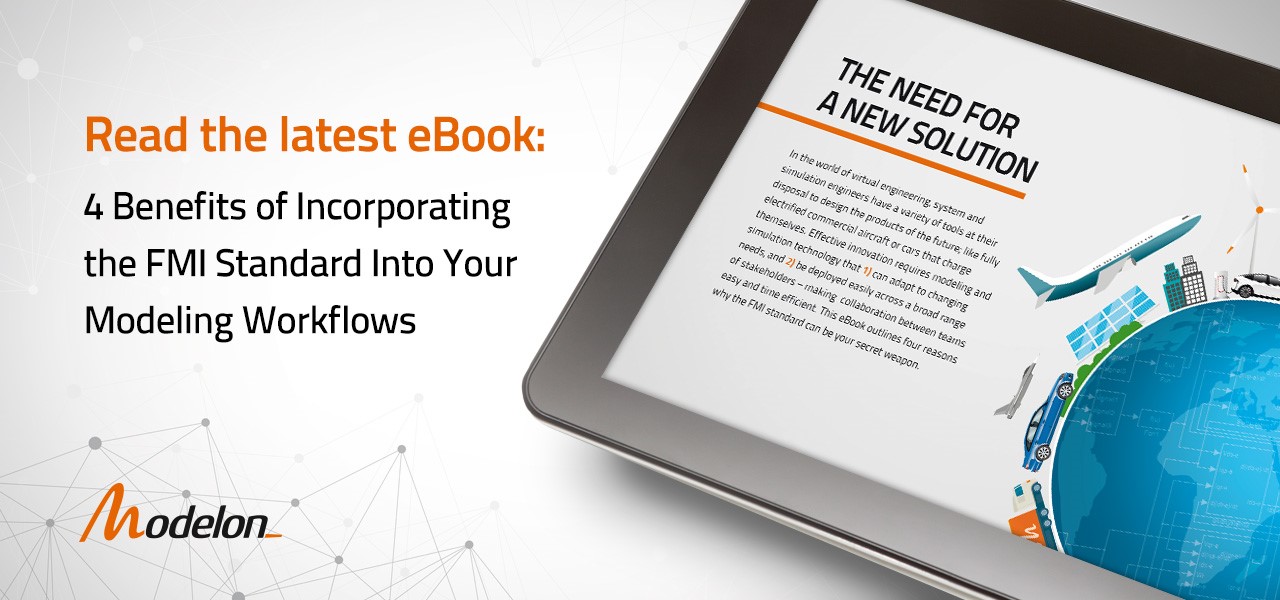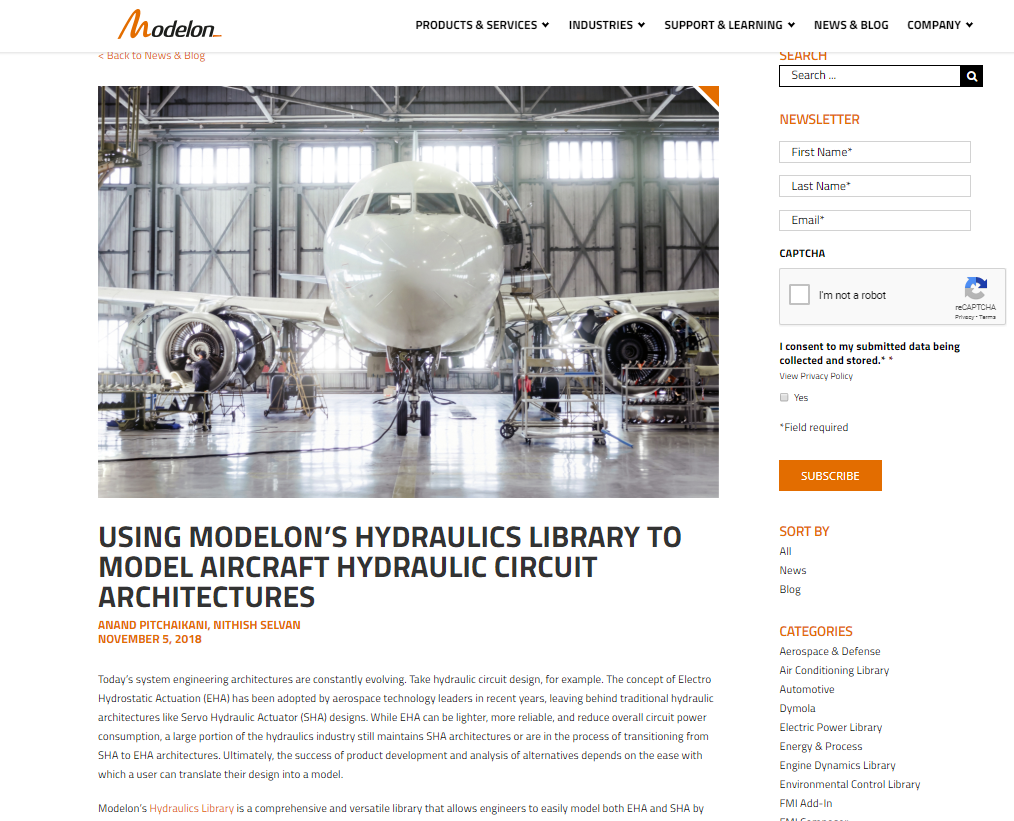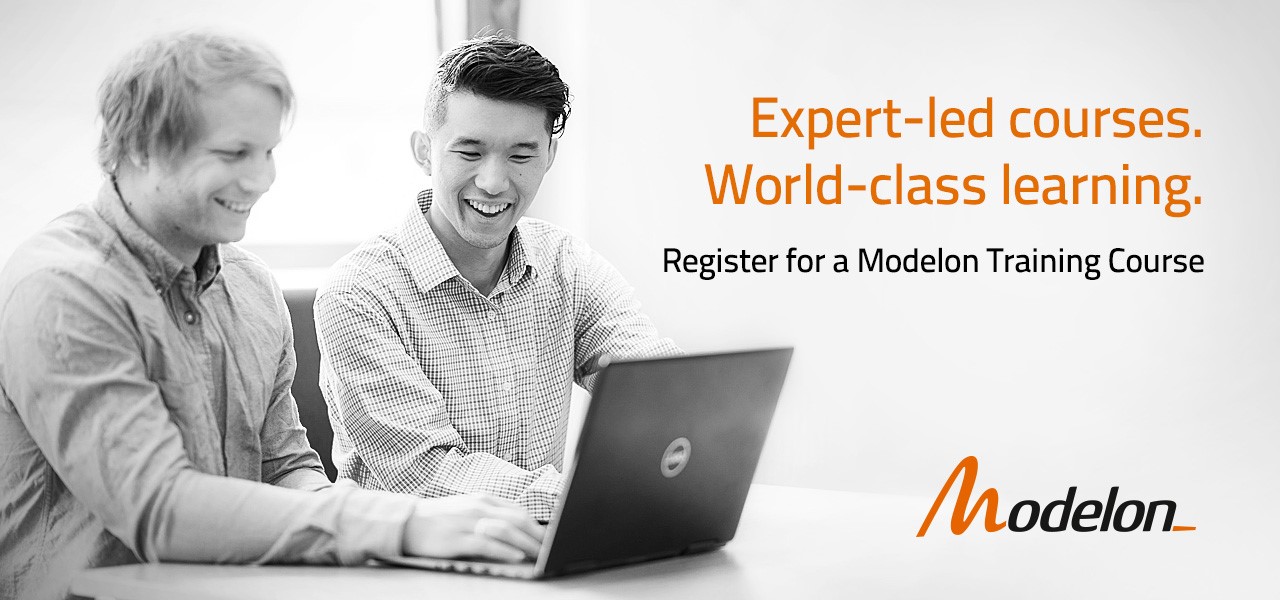Table of contents
- Letter from the Board
- Modelica Association
- Conferences and user meetings
- Vendor news
- News from libraries
- Education news
Letter from the Board
Dear Modelica, FMI, SSP, DCP interested,
The Modelica Association is very pleased about the successful first American Modelica Conference, held in Cambridge, MA, USA on October 9-10, 2018. The conference had 2 keynotes, 36 papers, 11 exhibitors and almost 100 attendees. A short report on the conference can be found here.
The 2nd Japanese Modelica Conference took place in Tokyo, Japan on May 17-18, 2018. The Conference Proceedings are currently available as one pdf-file. In the near future, the proceedings will be published by Linköping University Press.
The 13th International Modelica Conference will take place on March 4-6, 2019 in Regensburg Germany. The submission of regular papers was just closed (on Nov. 19) and we received nearly as much submissions as for the last International Modelica Conference 2017 in Prague, despite the fact that there had been two Modelica Conferences in 2018. We expect that the conference in Regensburg will have 400-500 participants. Note, it is still possible to submit extended abstracts of 1-2 pages for industrial user presentations by Jan. 7, 2019. The abstracts will be reviewed, but no papers will be published in the conference proceedings. Industrial user presentations are scheduled for the first day of the conference, on March 4, 2019. It is also still possible to submit proposals for tutorials, vendor sessions and exhibitions. The registration is already open and reduced conference fees are available up to January 7, 2019.
A new version of the Modelica Standard Library is under way, but due to some issues found in regression testing, it is expected that this version will be released end of this year.
A new maintenance version for the CSV Compare Tool has recently released for Linux and Windows. The tool allows comparison of simulation results and is used, for example, in the regression testing for the Modelica Standard Library. Note, the pre-built binaries of the FMU Compliance Checker are now also available at GitHub.
MA continues to move its infrastructure to GitHub. Therefore, please use the Issues at GitHub in the future to report bugs or suggest improvements: Modelica Specification, Modelica Standard Library, FMI Standard, and Modelica Compliance Checker.
The FMI Steering Committee has approved a new set of FMI Cross-Check Rules (FMI Cross-Check, FMI Cross-Check rules). Technically, the biggest change is that the rules are stricter about how files need to be submitted and how the rules are enforced before accepting commits. On the organisational site, the FMI group is introducing a fee for listing tools on the FMI tools web site. The money raised this way will be used to improve the FMI standard and the cross-check infrastructure. The FMI standard is (and will always be) license and royalty free, so neither the entry nor the usage barrier is raised. Starting in 2019, the fee for listing a tool at the FMI web page will be 1000.– Euro per calendar year for tools providing cross-check data with a green “available” button, otherwise it will be 2000.– Euro. Open-source tools are continued to be listed free of charge.
We are looking for interested people that are organizing Modelica Conferences in the future: The International Modelica Conference in 2021 in Europe and local Modelica Conferences outside of Europe in 2020. If you would like to organize such a Modelica Conference, please inspect the Modelica Conference series for instructions.
If you have interesting news for the Modelica, FMI, SSP and DCP communities, please follow the submission guidelines. The deadline for articles for the next newsletter is Fr. March. 15, 2019.
Martin Otter on November 23, 2019 (Chairman of the Modelica Association)
This article is provided by Martin Otter (Modelica Association)
Modelica Association
DCP Specification 1.0 Information
The DCP represents the latest addition to the portfolio of Modelica Association Projects. The “Distributed Co-simulation Protocol” is an application layer protocol that allows integration of real-time and non-real-time systems. The DCP was developed in the ITEA3 project ACOSAR. The “DCP Specification Version 1.0-Release Candidate 3” is in its last iteration round, and currently the release of version 1.0 is planned for the Modelica Conference 2019, taking place from March 4-6 in Regensburg, Germany.
Furthermore, DCP website is also under development and will go live soon. Check back on dcp-standard.org for updates. Meanwhile you may also check out the ACOSAR project website at acosar.eu.
This article is provided by Martin Krammer, VIRTUAL VEHICLE
Celebrating the 20th Meeting of the Modelica Users’ Group Saxony
In its sixth year after formation, the Modelica Users’ Group Saxony celebrated its 20th meeting in the office rooms of ESI ITI in Dresden, Free State of Saxony, Germany in autumn 2018.
With 3 or 4 meetings each year, this user group’s meetings are a valuable and relaxed get-together for exchange of experiences and news in the world of Modelica and Modelica Association Projects. Usually each meeting’s agenda lists diverse topics such as presentations of master or PhD theses, reports from participations in conferences or workshops, discussions on recent developments within the Modelica or FMI community or even recommendations of best practices in modelling or simulation. In this way, the group of more than 50 Modelica enthusiasts in Saxony proved to be one of the most active of all the Modelica User’s Groups worldwide.
The organizers and members of the Modelica Users’ Group Saxony are looking forward to continuing the success of the user group’s meetings in the future.
This article is provided by Thomas Beutlich (ESI ITI) and Volker Waurich (TU Dresden)
Conferences and user meetings
Siemens PLM Software – 2018 Simcenter Conference – Europe
Join us on December 3-5 for the European Simcenter Conference 2018
Discover the European Simcenter Conference 2018, an exciting event that brings together simulation, test and design exploration in an industry themed agenda that contains over 100 presentations from simulation and test experts.

For more information on Simcenter Amesim, please visit our website.
This article is provided by Bruno Loyer (Siemens PLM Software)
ESI SimulationX Confererence 2018

Under the motto System Simulation in the Era of Digital Transformation more than 170 participants met at the ESI SimulationX Confererence 2018 in Dresden to inform themselves once again within the SimulationX community about trends and new developments in the field of product development and system simulation. For 20 years now, the event has been an exchange platform for SimulationX users from all over the world. The focus is on the presentation of successful customer projects and the exchange of experiences between users, developers and experts from industry and science.
On the first day, the participants gained insights into current SimulationX projects in the fields of automotive development, industrial machinery, mobile machinery, aerospace and energy technology. On the second day of the conference, the presentation of the new release SimulationX 4.0 with new features and application possibilities was in the foreground.
ESI will welcome all SimulationX customers and interested parties at the ESI Forum in Germany 2019 in Berlin from November 6th to 7th.
This article is provided by Manuela Joseph (ESI ITI)
Report from the American Modelica Conference 2018
The new world opens to Modelica: Highlights from the very first American Modelica Conference 2018!
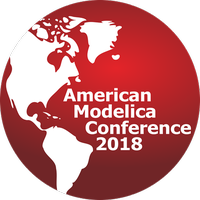
Thanks!
The very first American Modelica Conference, was held in Cambridge, MA, USA on October 9-10, 2018. The conference had 2 keynotes, 36 papers, 11 exhibitors and almost 100 attendees, among which 59 regular attendees, 15 students, 2 keynote speakers, and ~20 vendor representatives.
Having the honor of being the Program Chair, I am delighted to inform that the event was an outstanding success in every aspect. I do not want to list everyone involved in making this a success to avoid the risk of missing someone, so I would like to personally thank everyone involved in the conference and most importantly, our conference presenters, for sharing with the Modelica community about their exciting research and projects! It goes without saying that I had a wonderful time meeting old friends and meeting new colleagues.
As the Modelica community grows in the USA and North America, I am very hopeful that we will be able to replicate and synchronize with what makes the Modelica community unique - a truly open, welcoming, and above all, ** super cool ** technical collective of modeling and simulation experts that through its efforts it is making true impact in different domains crucial for today’s society. With the substantial challenges that the future holds for our world, the Modelica ecosystem and community is positioning itself as vital set of technologies and experts that can enable and inspire people to address these challenges.
Below, I have tried to provide you with some of the highlights of the event, from my perspective; hoping to encourage you to join us in the next edition of this event in this “new world” for Modelica.
Warm up!
As one of the traditional highlights of Modelica conferences for participants, this conference included three “pre-conference” workshops, organized on October 8th.
At Mitsubishi Electric Research Laboratories, two sequential workshops took place. In the morning workshop, Modelon provided an “Introduction to Modeling with Modelica” workshop, where more than 20 participants from industry and academia learn about the basics of Modelica with a web browser-based tool being developed by Modelon. Next, Michael Wetter of LBNL gave a workshop on “Thermo-fluid Modeling with Applications from the Buildings Library,” which made use of the aforementioned tool, and with more than 20 participants also; who learned the basics of the Buildings’ library, best practices in developing models using it, and built several models of their own. The participants, including this reporter and his students, found both workshops informative and very useful for their future research.
As a personal highlight, I had the pleasure of having lunch with “il Padrino”, Hilding Elmqvist, during the lunch break of this workshop. It was of course a great moment for someone like me that only joined the Modelica community 7 years ago, and I truly enjoyed discussing with Hilding about the enabling features of Modelica for cyber-physical system modeling. More on that below.
Concurrently, Jiri Kofranek’s team from Charles University offered a 1 day workshop on “Introduction to Equation Based Modeling and Simulation with Modelica with a Focus on Physiological Modeling.” This workshop was possible thanks to Michael Tiller’s efforts and aimed at exposing physiology experts to Modelica and the dedicated libraries from Charles University developed for this purpose. Participants learned how to model the cardiovascular system dynamics using principles from the hydraulics domain, among other interesting applications!
The Main Event!
We had the pleasure of having two amazing keynotes from two unique perspectives.
The first keynote was given by Dr. John F. Mckibben of Procter & Gamble on “Simulation Led Innovation at Procter & Gamble”. P&G is one of America’s major source of “consumer packaged goods”, think about toiletries, shampoo, and yes, toilet paper! The talk was an exciting expose of how simulation is enabling massive innovation possibilities with lower costs as compared to previous conventional prototyping approaches. Most importantly, Dr. Mckibben made a case that beyond mastering technology, to truly take advantage of modeling & simulation approaches, any business will need to change their mindset: the entire life cycle of digital assets (our models and simulators), needs to become as important of the physical assets. This aspect really struck a chord with me, as the world continues with the trend of digitalization - from smart homes to smart grids -, our “digital twins” will become a crucial part of our society, and as one of the world’s premier community of modeling and simulation experts, bringing this message out is an important role we can play.
The second keynote was given by Dr. Hilding Elmqvist, CEO of Mogram AB, and most importantly, the pioneer of Modelica. The talk “Modelica - History, State, Needs, Trends, and Possibilities” was an entire educational experience of its own. From the early challenges that Dr. Elmqvist faced with limited hardware, to the universe of opportunities that can be enabled with Modelica technologies, this talk made me learn, think and even laugh! To illustrate the point of evolution of the technology and current needs (i.e. self-driving cars), Dr. Elmqvist showed how he used a web-based tool to develop a Modelica model while letting his Tesla drive for him in the road; luckily, this was not illegal in Sweden when he recorded it! This really made me ponder on how digital assets, physical systems, and humans are becoming more interweaved, and how now, more than ever, the technologies of the Modelica ecosystem have a crucial role to play. To this point, Dr. Elmqvist illustrated the importance of making Modelica evolve through prototyping languages, such as Modia, to expand simulation standards to take advantage of Virtual and Augmented Reality (AR/VR), and other visions where modeling and simulation can help meeting the challenges today and the future.
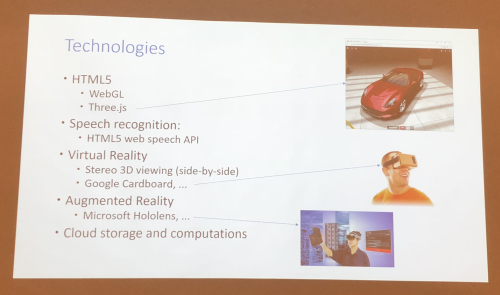
Finally, something that is really important for me as a Professor, was the topic of low-cost HIL simulation. Dr. Elmqvist showed a low-cost prototype HIL system with the controller on an Raspberry Pi and the model on a PC, to highlight that the available technologies today for HIL are now opening new opportunities. I loved this kind of “toy” examples because not only I work with real-time HIL simulation at ALSETLab and I want the models I run in my targets to one day be portable, but more importantly because they can truly help bringing more people young to the Modelica world, specially young students. I really hope Dr. Elmqvist will continue this effort, it can make my job as an educator much better, and help foster the future Modelica generations.
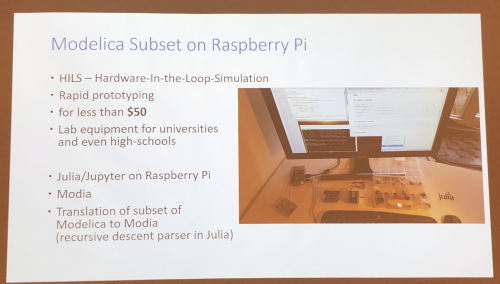
A Glimpse into the Conference Papers: My Top 3 Pics!
With nothing else than my own biased selection, I present to you some of my favorite papers during the conference, along with my own Guerilla-style photography, ;-)
1. A Total Eclipse of The Heart - On Mobile Now!
My dear friends of Charles University don’t stop surprising me every Modelica conference!
In this conference, Filip Ježek (shown in action below) presented their work using Modelica to publish and share biomedical models. I don’t need to emphasize how meaningful this work is, but I would like to show you how cool it is!
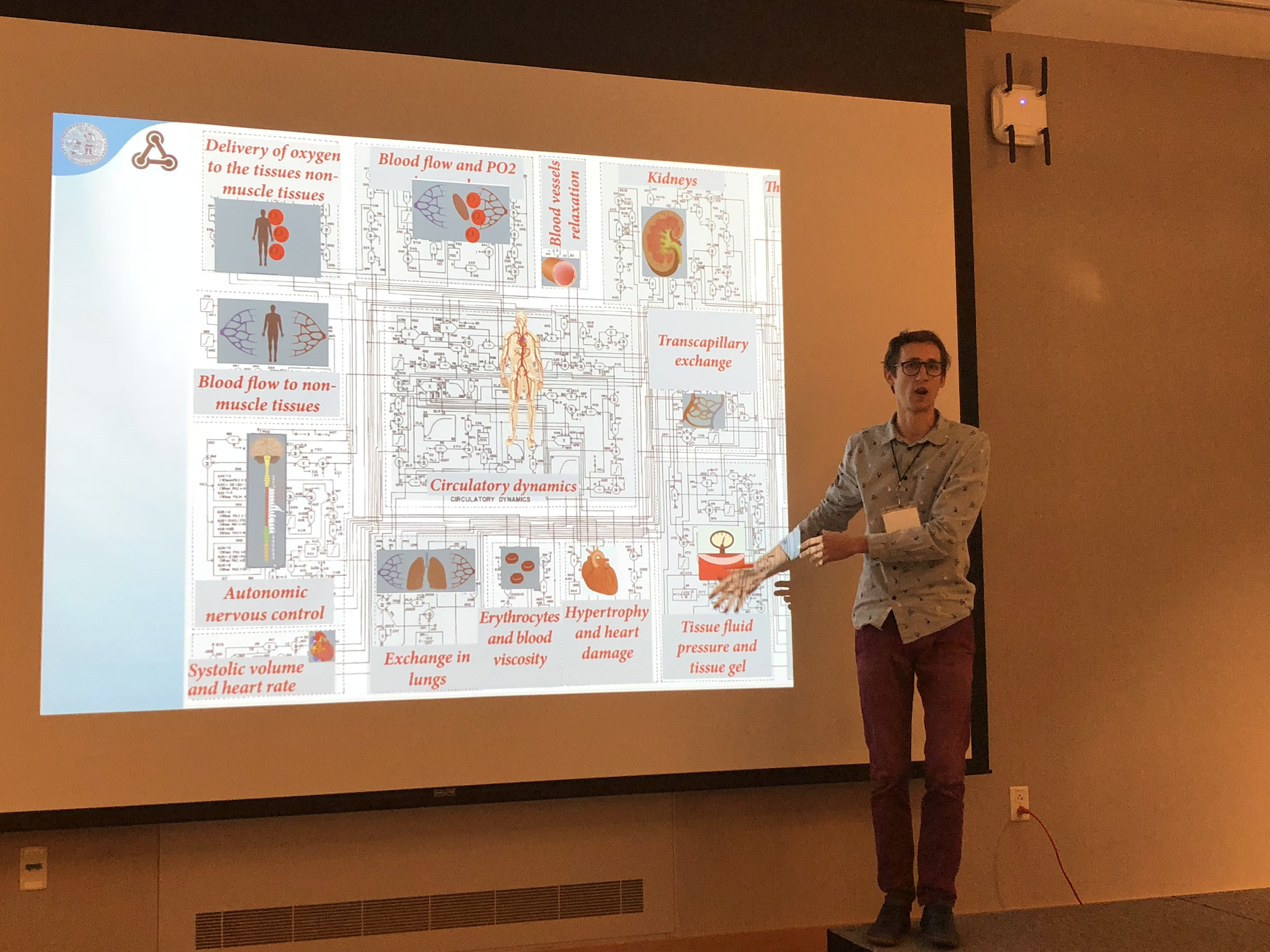
Take a look at a heart model on your mobile phone running on an FMU, here, or if you are sitting on your PC, open your browser and learn how circulation is affected by weight, height, and other factors here. You can find the full presentation here
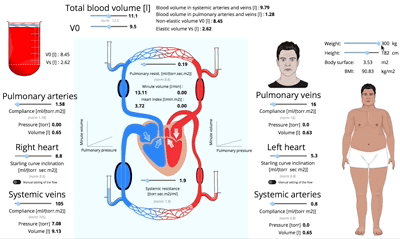
2. Born in the USA - There’s nothing cooler than DLM!
Have you ever heard of Dirt Late Model cars?
Me neither, but they are cool! Nothing more fitting for the 1st American Conference than a truly American sport!
Check out this amazing application of Modelica by Nate Horn of Claytex on developing Dirt Late Model car models and simulations here.

3. Too Hot! - In space?!
Tobias Posilek presented his work on “A Modelica Library for Spacecraft Thermal Analysis”. I’m a big fan of the work of DLR, and this library is an exceptional sample of their amazing work.
The library allows the simulation of the complete spacecraft system (thermal system, electric and mechanical), system solar angles, the form factor and a shadow function. Check out the slides here.
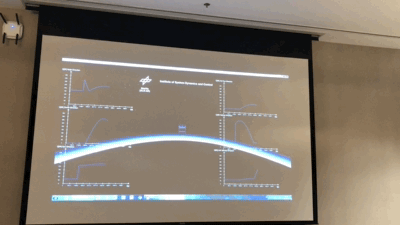
More Coming Soon!
Where’s the proceedings?
Along with Christopher Laughman of MERL, we are putting together the conference proceedings which should be available in the coming month.
Repository with Presentations
For those that can’t wait to enjoy the fun, for the time being, an unofficial draft of a repository (which will be transferred to the Modelica Association upon completion) is available here.
See you next time!
I hope you enjoyed reading this report, and I encourage you to join us in the next edition of this event in this “new world” for Modelica - I will personally be very happy to see so many of my colleagues in Europe more often!
Thanksgiving Day of 2018-11-22.
Dr. Luigi Vanfretti, Associate Professor, ALSETLab, ECSE Department, RPI, Troy, NY, USA
This article is provided by Luigi Vanfretti (Rensselaer Polytechnic Institute, Troy, NY, USA)
Vendor news
Simcenter Amesim 17 released
Siemens PLM Software is proud to announce the recent release of Simcenter Amesim 17. In this release, major development efforts have been put to help address key applications for electrification, controls engineering, vehicle systems and components performance engineering, aircraft systems performance engineering, and interoperability.

Extended Modelica language support
Thanks to the partnership established between Siemens and Modelon, Modelon’s OPTIMICA Compiler Toolkit can be used to create and/or include Modelica models within your native Simcenter Amesim models. This functionality is available upon request with Simcenter Amesim 17 and will be delivered as standard in the forthcoming release (expected in April 2019).
More FMI improvements
Simcenter Amesim 17 introduces four new FMI capabilities:
- More user-friendly run parameters for co-simulation FMUs: some rework has been made on the way run parameters (typically solver settings) are exposed by Simcenter Amesim co-simulation FMUs. Now, these parameters are always relevant, self-explaining and mapped to standard FMI enumerations whenever possible.
- Structured naming convention at FMU import: when imported into Simcenter Amesim, FMUs using the structured naming convention (dotted names) get their parameters and variables now presented in a convenient and hierarchized tree view.
- Structured naming convention at FMU export: like Modelica FMUs for instance, Simcenter Amesim FMUs are now exported using the FMI structured naming convention. This is more convenient within importing environments that leverage structured parameter and variable names.
- Tunable parameters for FMI 2.0 export/slave: exporting Simcenter Amesim 2.0 FMUs with tunable parameters is now possible. This can be used for controls calibration on compatible real-time targets such as dSPACE SCALEXIO. Another use case consists in switching between various mission profiles (chained maneuvers) in a Hardware-in-the-Loop context with no need to restart the model.
More will come in the next release, along with tunable parameters extended to components from various libraries. Virtual calibration directly within the Simcenter Amesim environment through interactive dashboards will also be made possible. Stay… tuned!
For more information on Simcenter Amesim, please visit our website.
This article is provided by Bruno Loyer (Siemens PLM Software)
Siemens partners with Modelon
Siemens partners with Modelon to use OPTIMICA Compiler Toolkit as its Modelica engine starting of Simcenter Amesim 17¹
Siemens and Modelon signed an agreement to integrate Modelon’s OPTIMICA Compiler Toolkit (OCT) within Simcenter Amesim. This agreement will allow Simcenter Amesim users to develop, enhance and reuse Modelica libraries to describe dynamic multi-physical systems, and combine them seamlessly with Simcenter Amesim native libraries.
Such a model will benefit from the full support of the Modelica standard and optimized code generated by OCT, and will be simulated by the Simcenter Amesim solver while being compatible with noticeable Simcenter Amesim platform capabilities such as Performance Analyzer or Linear Analysis.
The support of Modelon’s industrial libraries through this workflow will come in future releases.
“Do not choose between causal and acausal approaches: enjoy the best of both worlds within the same environment!”

[1]: Available upon request in Simcenter Amesim 17.
For more information on Simcenter Amesim, please visit our website.
This article is provided by Bruno Loyer (Siemens PLM Software)
Modelon November 2019 Updates

Modelon provides software solutions and expert services to organizations that use model-based simulation tools to design and develop technical systems. Modelon’s libraries, solver,and deployment solutions are leading products available in the market today for modeling, simulation, and optimization. Our products enable companies to focus on delivering a unified picture of product system interaction and performance - from product concept to operation.
New Products
Electrification Library
![]()
Modelon’s Electrification Library is used for the design, analysis, and control of electrified systems. Learn about the Electrification Library here.
Aircraft Dynamics Library
![]()
Modelon’s Aircraft Dynamics Library is a comprehensive library for modeling and simulating full aircraft and aircraft subsystems. Learn about the Aircraft Dynamics Library here.
2018.2 Release
Are you using the most up-to-date Modelon software? Learn about the latest updates to products within the Modelon Library Suite, the Modelon Creator Suite, and Modelon Deployment Suite as part of our 2018.2 release here.
New eBook: 4 Benefits of Incorporating the FMI Standard Into Your Modeling Workflows
How much do you know about the Functional Mock-up Interface (FMI) standard? Modelon’s new eBook simplifies what the FMI standard is and outlines how it can be used to integrate models across varying simulation tools. Download a free copy today.
Case Study: Rimac’s Journey Towards Full Vehicle System Simulation
Rimac, a Croatia-based automotive technology powerhouse, needed a more efficient and flexible way to evaluate multi-physics powertrain systems. In this new case study, learn why Rimac chose Modelon’s libraries and services, including Modelon’s newest library, the Modelon Electrification Library, to meet their electric powertrain modeling, battery modeling, and full vehicle system simulation needs.
New Blog: Using Modelon’s Hydraulics Library to Model Aircraft Hydraulic Circuit Architectures
Aircraft hydraulic system simulation requires a versatile tool that can handle modern and legacy concepts. This blog presents how the Modelon Hydraulics Library is applied to different architectures, specifically Electro Hydrostatic Actuation and Servo Hydraulic Actuation systems. Read it here.
Upcoming Training Courses
Modelon offers expert-led training courses on topics such as FMI, Modelica, multi-physics modeling, and more at varying learning levels. To view our available winter courses, check out our training page.
Don’t see a scheduled course that works for you? We also offer customized training. Contact our training team at training@modelon.com to find a course right for you.
This article is provided by Swati Tyagi, Modelon
Dymola 2019
Dymola 2019 FD01 will be released on November 30, 2018.
Simulation and Experimentation
Experimenting with different parameter settings or initial conditions is one of the most common simulation tasks. A new user interface for sweeping parameters makes it easy to experiment with different parameter settings and plot curves or surfaces to visualize the result.
Some models are inherently hard to initialize. Saving start values after initialization and selection of iteration variables can for certain models give more robust handing of difficult equation systems and increase simulation performance.
Other improvements
To speed up model editing, improved search filters makes searching for models and components easier. This is particularly valuable when working with large and complex libraries of models.
Installation of Modelica libraries facilitated by new dialog that unpacks and installs the library where Dymola can find it. After downloading the library from a server, the user can ask Dymola to display the contents in order to select which parts should be installed. After that, Dymola will copy the contents into a location where subsequent sessions will find it.
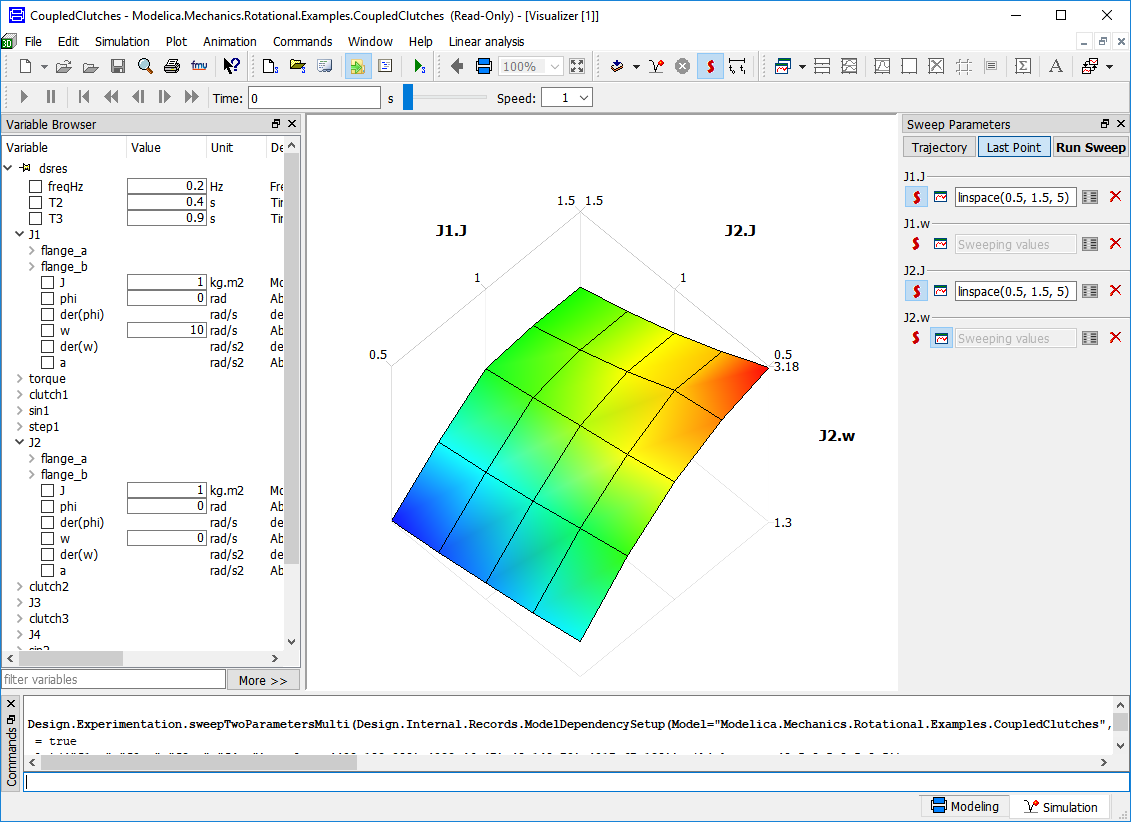
This article is provided by Dag Brück (Dassault Systemes)
News from libraries
TLK TIL Suite - New version 3.6.0
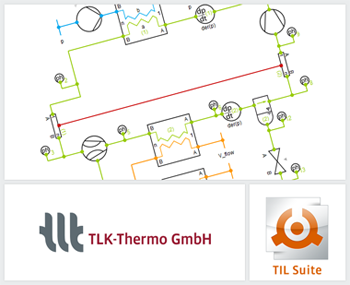
The TIL Suite enables stationary and transient simulations. The current version 3.6.0 includes new and improved components and system models. Among other things, we would like to draw your attention to the following innovations:
- Adapter-models between TIL & MSL connectors for Gas, Liquid and VLEFluid are now available.
- New Liquid-Bend-HydraulicResistor using pressure loss from MSL Fluid Dissipation.
- Kv-values are available in the Gas-, Liquid- & VLEFluid-Valve beside the effectiveFlowArea.
- Gas-Junction, -Tube and -Volume can be initialized with the relative humidity phiInitial.
For further information see www.tlk-thermo.com, download the TIL presentation or contact us at til@tlk-thermo.com.
This article is provided by Matthias Kwak TLK-Thermo GmbH
TLK TILMedia Suite - New version 3.6.0
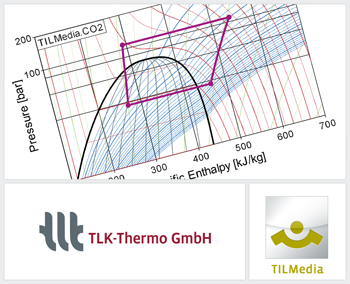
The TILMedia Suite provides methods of calculation, which express the thermophysical properties of incompressible liquids, ideal gases and real fluids containing a vapor liquid equilibrium. Among other things, we would like to draw your attention to the following innovations in the current version 3.6.0:
- New Liquid TILMedia.Novec7500: ‘3M™ Novec™ 7500 Engineered Fluid’.
- New TILMedia Java interface for Windows.
- Introduced base classes in Modelica.
- Added new medium class in Modelica
For further information see www.tlk-thermo.com, download the TILMedia presentation or contact us at tilmedia@tlk-thermo.com.
This article is provided by Matthias Kwak TLK-Thermo GmbH
Beta-Release of the DLR RailwayDynamics library
Railway vehicles are complex multibody systems running at high speed along a given track. The particular contact between profiled steel wheels and rails carries the payload, provides lateral guidance and submits traction forces. The running gears and their suspensions ensure track-holding and control the vibration comfort, which the passengers perceive. These are the vehicle dynamical issues the new commercial DLR RailwayDynamics library is dedicated to.
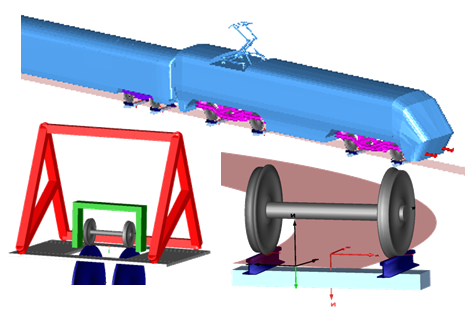
However moreover, the library proposes a sound modeling framework to support multidisciplinary engineering tasks, which are almost generally given in railway vehicle design. Pneumatic friction brakes and air suspensions, electrical engines, Diesel-electric or Diesel-hydraulic drive trains are prominent examples and now may be analyzed together with vehicle dynamics in one consistent simulation environment.
On this basis, the intended use of the DLR RailwayDynamics library includes the design, the optimization and control development as well as hardware and software in-the-loop testing mainly on the system level. This is the mission of the System & Control Innovation Lab at DLR that contributed to the library and offers support to bring associated tasks into service.
The library is now available as a beta-release for interested parties and intended to be commercially distributed after the Modelica Conference 2019.
Contact: Dr. Andreas Heckmann, DLR, Institute of System Dynamics and Control, andreas.heckmann@dlr.de
This article is provided by Andreas Heckmann, DLR
Release of PowerSystems version 1.0.0
The Modelica PowerSystems library is intended for electrical systems at different levels of detail both in transient and steady-state mode. The library results from application driven long-term research on Modelica formulations for electrical power systems, carried out within the ITEA projects MODRIO and EUROSYSLIB as well as the RealSim project. PowerSystems is maintained by Modelica Association and proves useful in today’s industrial applications. The applications range from microgrids to high-voltage transmission grids and HVDC.
The figure shows an examplary model of a wind farm with collector grid, zooming into the drive train model of one wind turbine.
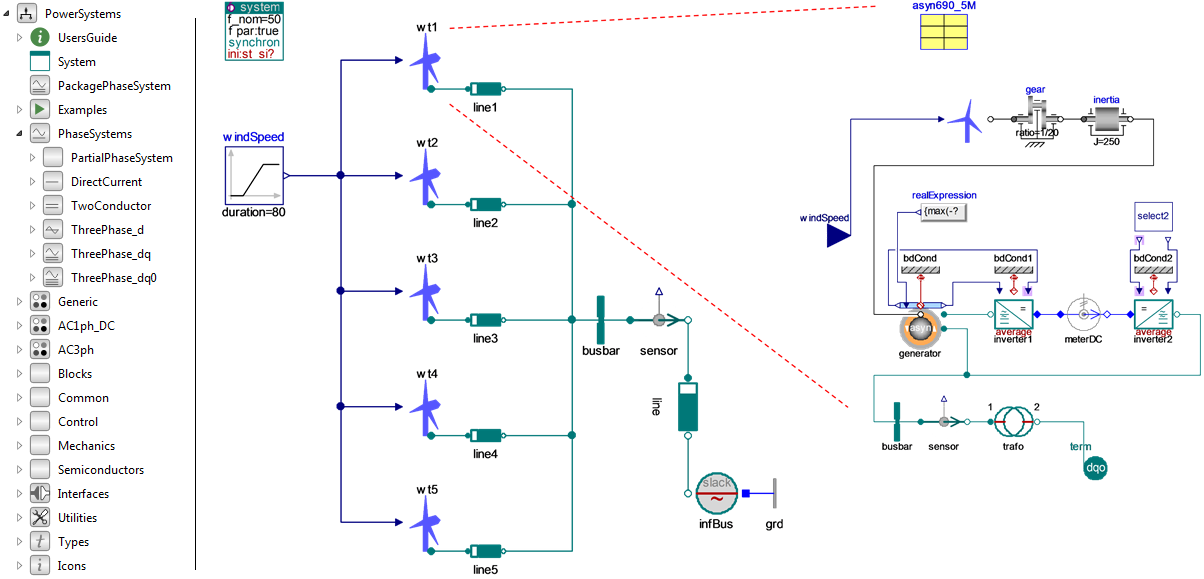
Replaceable phase systems are the predominant feature of the library. This enables different modeling assumptions, resulting in models with different level of detail using one and the same library. Not only high-fidelity transient three phase models are covered, but also reduced steady-state and DC flow models.
The subpackage Generic contains simple textbook examples that adapt to each phase system.
The subpackages AC3ph and AC1ph_DC contain detailed models of electrical components, such as Breakers, Faults, Impedances, Inverters, Lines, Loads, Machines, Drives, Generation, Shunts and Transformers. The detailed component models are tailored for specific phase systems and are configured with parameter records.
This article is provided by Rüdiger Franke (ABB)
Pneumatic Systems Library 1.1 - New version for Dymola 2019
The Pneumatic Systems Library (PSL) is intended to assist the development of pneumatic systems. PSL enables predicting the system behavior for a wide range of industrial applications such as industrial machines, pneumatic brakes or suspension systems as well as cooling and engine bleed air systems for aerospace.
In this release 1.1, the following improvements and more were made:
- UsersGuide: Documentation for NeglectKineticEnergy.
- Gases: Add a warning for ImportFromMSL when using an incompressible medium.
- Sources: VaneCompressor is now able to start from zero movement.
- Valves: Add V33 valves with a zero flow position between the end positions.
- Actuators: Add preconfigured cylinder setups.
- Piping: Add Fitting component to estimate pressure losses due to flow area changes.
- Sensors: Add VolumeFlowRate and VolumeFlowRateNormalized Sensors.
For further details, please see the UsersGuide.
V33 valves have been introduced to allow a zero mass flow position between the two end positions of the valves. Additionally, for all valves with pneumatic actuation the option to use a reference port has been implemented. It can apply a counter pressure on the actuation pressure.
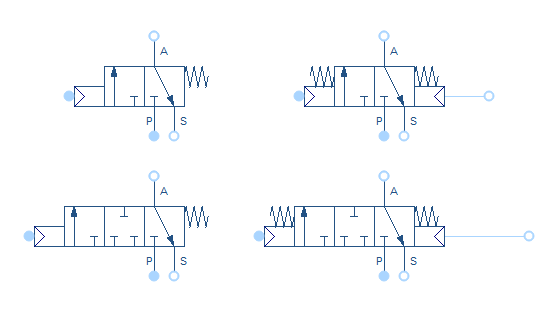 The newly introduced valves: V33 (bottom) and valves with a reference port (right side).
The newly introduced valves: V33 (bottom) and valves with a reference port (right side).
To demonstrate the application of the PSL for complex models, a pneumatic train brake system has been added to the examples:
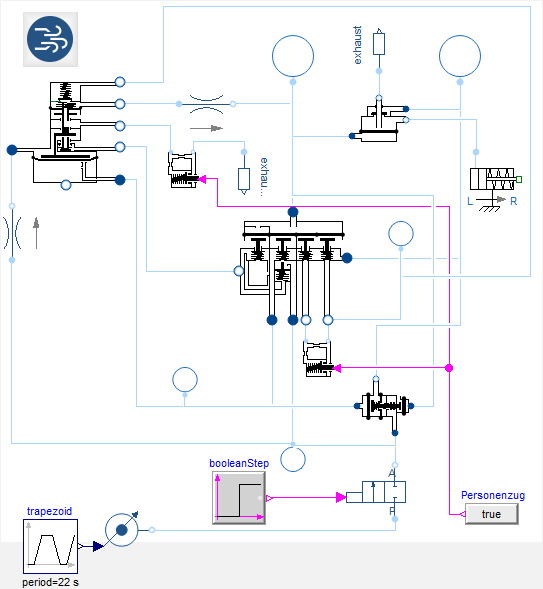 This examples covers most of the functional properties of a pneumatic train brake system: A reduction of the train driver brake pressure leads to an increase in the brake pressure. The system is fail-safe as every brake cylinder has it’s own pressure reservoir.
This examples covers most of the functional properties of a pneumatic train brake system: A reduction of the train driver brake pressure leads to an increase in the brake pressure. The system is fail-safe as every brake cylinder has it’s own pressure reservoir.
This article is provided by Maximilian Kormann (Dassault Systèmes Deutschland GmbH)
Modelica DeviceDrivers v1.6.0 Release
The Modelica device drivers library (MDD) is a free library for interfacing hardware drivers to Modelica models. Version v1.6.0, released on Oct 6, is a new main release. It is compatible to MLS v3.3r1 (i.e., no Modelica language features of newer MLS v3.4 are used) and is backwards compatible to the previous MDD v1.5.1. With this latest release the library’s license was changed to the new Modelica Association license for libraries: The 3-Clause BSD License.
The main enhancement is support for MQTT (Message Queuing Telemetry Transport protocol) client communication for IoT (Internet of Things) messages with following features:
- Wrapper of the Eclipse Paho MQTT C client v1.3.0
- Support of (secure TLS encrypted) TCP and Websockets
- Support MQTT v3.1, v3.1.1 and v5.0

Further enhancements include:
- Number of received bytes in UDP receiver is provided as output
- Scalable real-time synchronization
- Utility function to retrieve MAC addresses
- Utility function to generate a UUID
The library is developed at github.com/modelica/Modelica_DeviceDrivers where the issue tracker provided by GitHub can be used to report bugs, feature requests or other issues.
This article is provided by Bernhard Thiele (DLR) and Thomas Beutlich (ESI ITI)
Education news
Training Courses for Modelica and TIL
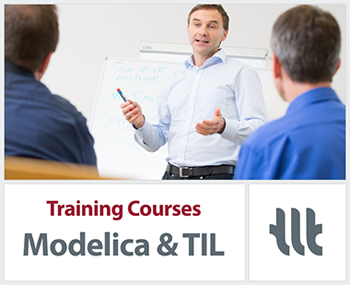
TLK-Thermo offers two day Modelica training courses for learning basic and advanced object oriented modeling. The Modelica course is an introduction to the most important features of Modelica, including numerical aspects. With many practical exercises the participants will learn how to design and implement Modelica libraries (not only within thermal science).
Furthermore, we are offering a one day course for thermal system modeling with the Modelica library TIL. The training course is directed towards simulation and modeling specialists with basic knowledge of the Modelica programming language. It can be seen as an advanced course to the basic Modelica training.
The next training course will take place in Braunschweig on 22nd to 24th of January, 2019.
For further Information regarding our courses see TLK-Thermo training courses or contact us at training@tlk-thermo.com.
This article is provided by Matthias Kwak TLK-Thermo GmbH
